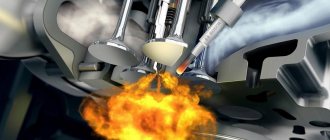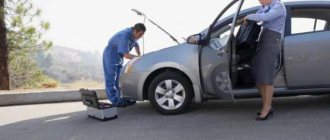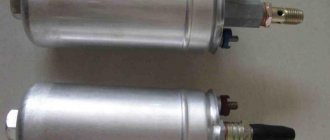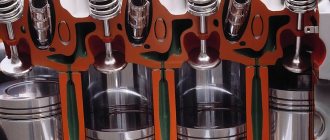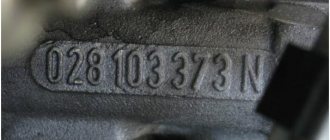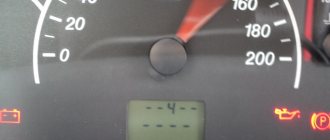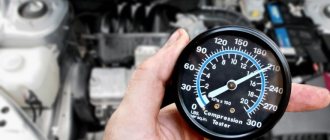Every car owner sooner or later encounters various car troubles, and Lada Priora owners are no exception. Various problems occur, including when it is difficult to start when cold. There are many reasons for such problems when starting a car is difficult. In this material we will analyze in detail the reasons when a car does not start, as well as when it troits and stalls when cold.
Main types of “bad” launch
Typically, experienced drivers immediately assess the malfunction in the following way: “Poor hot start.” That is, it is clear that there are 3 types of bad startup:
- Poor cold starting.
- It starts poorly when the engine is hot.
- Doesn't start well in any condition.
This means that these three types have their own characteristics, although they are united by one sign - the car is difficult to start. But in the first case, this only happens when the car has cooled down. Either this is the first start in the morning, or the Priora has been sitting long enough for the engine to cool down completely, or it is a harsh winter.
In the second case, the Priora does not start immediately, but only after several full turns of the crankshaft with the starter only when the engine temperature is above 90 degrees. That is, a fully warmed up engine. Usually after some mileage.
Well, the third option is when Priora is capricious in any conditions. Be it in the morning, at lunch or in the evening, on a cold or hot engine. Here we will consider the minimum possibilities that the owner has to solve this problem on his own.
How to fix problems after washing
For each situation there is a solution. If the driver used the services of a car wash, then you need to check whether water got inside the car
It is especially important to do this if the motorist has washed the engine and the car does not start. When carrying out a regular washing of the surface of the car, it is necessary to open the hood at the end of the work and check for the presence of water near the engine and other important elements
The battery, terminals, spark plugs and all wiring must be thoroughly wiped down so that moisture does not increase the amount of current drawn or drain the battery. If visiting the car wash was a fairly frequent procedure, then you need to check for gray deposits on the battery terminals. It prevents normal contact and, as a result, normal operation of the battery.
It is best to wipe the area under the hood with a soft cloth or sponge, as they absorb water best. The sponge allows you to remove moisture even in the most difficult to reach places. After wiping off the water, the car should start normally.
If the car does not start after washing the engine, this will require a more thorough inspection. First you need to inspect the spark plugs, since wet spark plugs do not produce a spark. Water under the distributor cap will also prevent the car from starting. It will need to be unscrewed and wiped completely.
Water can also accumulate in the spark plug wells, so it is better to blow them out. All wires must be inspected and, if necessary, thoroughly wiped to prevent short circuits. All this must be done before starting the engine for the first time after washing. Then you can prevent a number of problems and prevent serious breakdowns.
There are situations when, after water gets in, the car’s electronics behave strangely. This manifests itself in the fact that the car does not start when the driver has washed the engine, and the immobilizer is on. An immobilizer is an anti-theft device that, using a special program, can stop connecting electrical circuits in the most important areas.
You can avoid a flooded engine when you do not use a high-pressure car wash. It is these devices that drive water inside the motor, which prevents its normal operation. It is best to wash the engine by hand, the old-fashioned way, and clean hard-to-reach areas with a brush. This will take more time, but will not cause problems with starting the car.
Hot
So, the car drove some distance. In the morning it started up with a half-turn, and forward. But then some distance was covered, a stop was made, the key was turned to “start” and... Several painful revolutions, and only then the engine started working. What's happened? As a rule, there can be many reasons. Conventionally, they can be divided into groups:
- The fuel system is acting up.
- Errors or breakdowns of sensors or actuators of the control system.
- Engine wear.
The first step is to check the presence of fuel in the injector frame. Gasoline supply is the most likely cause of problems. To do this, you need to open the hood and remove the decorative trim from the engine. The intake manifold runs between the engine and the Priora radiator. Below it is a fuel frame. At the end there is a special bypass valve, closed with a plastic cap. You need to unscrew it and press on the core. A strong release of fuel should occur.
When connecting this device, you need to turn on the ignition without trying to start it. The pressure must be at least 2.6. There is another option. Not so reliable, but quite usable. Perform the download several times before starting if the Priora is difficult to start. That is, without turning on the starter, wait until the fuel pump turns off, turn off the ignition and turn it on again without the starter. Do this several times. And then turn the engine. If starting improves, it means there was not enough pressure and you need to check the filters and fuel pump.
And another reason related to the fuel system is the banal clogging of the injectors, which gives the effect of poor starting to the same extent. But this is just a specialist checking the entire fuel frame at a special stand.
Electronic part of the check
Here it is worth clarifying immediately. There can be no talk of any complete determination of the cause of a poor startup without computer diagnostics. Although several positions can be checked. The easiest way is to check the performance of the Priora cylinders. To do this, you need to remove the decorative cover, start the engine and leave it at idle. Let it work a little and try to remove the connectors from the ignition modules one by one.
This requires good hearing and attentiveness. It is necessary to clearly determine which of the cylinders, when switched off, the operating rhythm changes the least.
If the Lada Priora's starter does not turn
| Possible malfunction | Diagnostics | Remedies |
| Low battery | The voltage at the battery terminals without load is less than 12V. When trying to start the engine, a cracking noise is heard from under the hood. | Charge the battery or replace it with a new one |
| Oxidation of battery terminals or wire terminals, their fit is not tight | When you try to start the car, the voltage in the on-board network drops much more than at the battery terminals. In this case, a crash may be heard under the hood. | Clean the contacts, lubricate them with petroleum jelly and tighten the terminals |
| The engine or attachments are jammed | Check the rotation of the crankshaft, pump and generator pulley. | Repair engine, generator, pump |
| The starter is faulty, the starter drive gear or flywheel ring teeth are damaged | Remove and inspect the starter. | Repair or replace starter |
| The starter switching circuit or starter relay is faulty, the wires are damaged, or the ignition switch contacts do not close | When the key is turned to position “II”, the starter traction relay does not operate (a click is not heard under the hood). Check the +12V supply to the control contact of the traction relay. | Replace starter relay, wires, ignition switch |
| The starter traction relay is faulty, there is a short circuit or break in the retractor winding, the relay armature is stuck | When the key is turned to position “II”, the traction relay does not operate (there is no click under the hood), but + 12V is supplied to the control contact of the traction relay. Remove the relay and check its operation. | Replace the traction relay |
| Contacts or wires of the traction relay are oxidized, poor ground contact | When the starter is turned on, a clicking sound is heard under the hood, but the starter armature does not rotate. Using an ohmmeter, check the resistance of the Battery-Starter circuit, as well as the ground wire. If the circuit is in good condition, remove the starter and check the operation of the traction relay by applying +12V to it from the battery | Tighten the terminals, clean the contacts, replace the traction relay |
| Open or short circuit in the holding winding of the traction relay | When you try to start the engine, you hear a crashing sound under the hood. The battery voltage is within normal limits. We check the traction relay with an ohmmeter or by its excessive heating. | Replace the traction relay |
| Burnt starter commutator, stuck brushes or severe wear Open or short circuit in the starter armature winding | The starter armature rotates slowly or does not rotate at all. Check the traction relay by applying voltage to the starter contact bolt directly from the battery | Replace starter or armature |
| Freewheel slipping | When the starter is turned on, the armature rotates, the flywheel is stationary | Replace clutch or starter |
In the cold
Morning, key to start. The starter cranks the engine, but the Priora does not start right away. Where to start? In general, most of the reasons are the same as for a bad hot start. The only difference between the second option is that here, failure in the electronic part is more common. That is, the sensors and actuators of the Priora are acting up. By the way, launching Priora in cold weather is a separate topic. Although cars with distributed injection themselves tolerate frost much better than carburetor cars. While with a “hot start”, more often the problem is in the fuel system. At the same time, if the Priora does not start well in any condition, then most often it is engine wear.
But we definitely need to remind you that the most reliable testing method for Priora is computer diagnostics. The methods described here, of course, will help an experienced driver find and fix a minor breakdown, but only diagnostics will reveal a specific malfunction.
Automotive diagnostic equipment
- List of forums ‹ Diagnostics ‹ Diagnostics of domestic cars
- Change font size
- For print
- RSS
- FAQ
- Registration
- Entrance
Battery
As you know, when you turn the key, the starter is activated, which begins to rotate the crankshaft. If there is no reaction from this unit to the described action, they first go to the battery. It is well known that if the voltage drops to 10 volts or below, the starter, in principle, will not be able to work. However, it is worth understanding that low readings do not always indicate problems with the battery. Quite often this is caused by unsuccessful attempts to start the engine. To avoid battery drain, do not repeat them more than 2-3 times. The problem also occurs due to improper operation of the generator.
In any case, the battery will need to be fully charged. Only after this can you try to start again. In order not to waste time, it makes sense to replace the battery with a known good one.
You can also ask permission from someone you know to connect directly to their battery. If the problem is only in the battery, the engine will start without difficulty.
When this element is working properly, it produces a voltage within 14 volts, provided that the engine is idling and there is no load on the vehicle's electrical system.
In this case, the first start leads to an increase in voltage by 2 volts. Later, stabilization occurs to standard levels. They are also affected by:
- battery condition;
- load;
- air temperature.
Problems with the generator are very often the reason for the inability to start the engine. In cold weather, the voltage can fluctuate from minimum values (12.9) to maximum values of 14.8 volts.
The 16-valve Priora in such a situation needs to inspect its generator. It is easy to verify its functionality by connecting the power directly, bypassing the regulator. If it is possible to detect excess voltage, the latter relay needs to be replaced.
Priora, bad morning start. (solved)
Priora, bad morning start. (solved)
nail1960 » 02 Aug 2014, 22:14 | Message: #1
Re: A373DA02 M73 21126-1411020-11 21126 E-3
sergeyelektri » 03 Aug 2014, 00:33 | Message: #2
Re: A373DA02 M73 21126-1411020-11 21126 E-3
nail1960 » 03 Aug 2014, 01:10 | Message: #3
Re: A373DA02 M73 21126-1411020-11 21126 E-3
jazz » 03 Aug 2014, 05:44 | Message: #4
Re: A373DA02 M73 21126-1411020-11 21126 E-3
Mikhail58 » 03 Aug 2014, 09:59 | Message: #5
Re: Priora, bad morning start.
nail1960 » 03 Aug 2014, 11:47 | Message: #6
Re: Priora, bad morning start.
kisel65 » Aug 03, 2014 12:25 pm | Message: #7
Re: Priora, bad morning start.
nail1960 » 03 Aug 2014, 13:02 | Message: #8
Re: Priora, bad morning start.
Serg57i » 03 Aug 2014, 16:02 | Message: #9
Nail, hello. I read this phrase and was reminded of my favorite movie “National Security Agent”. There, too, the syncopation in the bass in the third measure was delayed. Joke. No offense. As a matter of fact, I am also inclined to incontinence of the injectors. There was a similar case with ten, but they didn’t let me finish the job. I’m just aware of the result that others achieved. After all, they urgently and immediately need to issue a decision and don’t care about the specifics of the creative process. One of my former bosses, who was especially impatient, told me as an engineer: “Think fast!”
Main reasons
It is very difficult to immediately find out why the engine refuses to start when it is cold. There can be two options here - either there is no spark, or there is no fuel. But if you look deeper, you can identify other problems. Let's look at the most basic reasons for cold starting of the Lada Priora engine.
Experts identify the following problems. These are low quality fuel, clogged injectors, clogged fine fuel filter, malfunction of the fuel pump, incorrect pressure adjustment in the fuel rail, clogged air filter, dirty throttle valve, clogged idle valve and low ambient temperatures during engine starting. Also, the Priora has difficulty starting when cold due to faults with the mass air flow sensor and temperature sensor.
Replacing the gas pedal on Grant
The replacement procedure is quite simple and does not require special technical means. In order to dismantle the unit you will need: - A key for 10.
Sequential steps to replace the gas pedal of a Lada Granta:
1. The first step is to remove the negative terminal from the battery. 2. Next, you need to move to the driver’s side of the car. 3. Above the gas pedal, find and disconnect the contact chip that is connected to the sensor connector.
4. After that, take a 10mm wrench and unscrew the three fastening nuts. When there is insufficient internal space, it is most convenient to use a socket wrench. 5. Remove the pedal from the special mounting pins. Reinstallation is carried out in a mirror sequence.
Adjusting the sensitivity of the gas pedal
"Note! Not only the pedal and its module take part in controlling the operation of the throttle valve; the throttle control unit plays an important role. Therefore, this product should also be given special attention in cases where the MPG is in a known good condition, but problems with engine speed remain.”
Source
Low quality fuel
At domestic gas stations, low-quality fuel is by no means uncommon. But even at branded gas stations you can buy low quality gasoline. As a result, the car will be difficult to start. The car will leave the gas station on the remaining old gasoline, and the engine will be warmed up. But after being idle, it will be quite difficult to start the car. There are several types of low-quality gasoline.
Fuel may be dirty: it may contain various deposits. They clog the fuel channels as well as the filters. As a result, the pressure in the fuel rail will be insufficient, and it will be very difficult to start the engine.
Gasoline can also be low octane. Most often, with such fuel, the car may not start when cold even the third time. You will hear the noise the engine is making, you will feel weak thrust, and detonation will occur. Experts do not recommend starting a car on this fuel.
To eliminate the cause, it is enough to drain the bad fuel and then flush the fuel system. Then you need to fill the tank with good gasoline.
Fuel pump
This is one of the popular reasons why Priora has difficulty starting when cold. This is due to a malfunction in the fuel pump. You can even hear the sound of the node operating. But if the pump is faulty, the fuel system will not have the pressure necessary for normal operation. There is no pressure in the fuel rail, which means that starting will be poor, or the engine will not start at all.
The fuel pump can only be checked using your ears. You need to turn on the ignition of the Lada Priora. At the same time, if the fuel pump is working, a characteristic buzzing sound will be heard from the side of the tank. It will only last a few seconds. When a sufficient amount of gasoline is pumped into the ramp and the pressure becomes normal, then the pump will turn off. If there is no buzzing sound after turning on the ignition, it is recommended to replace the fuel pump.
Sources of the problem
Communities Lada Priora Lada Priora Club Blog what is affected by the clutch release switch The reasons why the Lada Priora does not start may be a malfunction in the fuel system:
- clogged fuel filters;
- failure of the fuel pump;
- lack of gasoline in the tank;
- clogged injectors;
- condensate freezing in the fuel line.
Having certain skills, every car enthusiast can fix these faults with his own hands. First you should check whether gasoline is supplied to the ramp with injectors. To do this, you need to disconnect the fuel hose from the rail and connect the pressure gauge. Then ask an assistant to start the engine. When the fuel pump is running, the pressure in the fuel line should be 2.7 atmospheres. If the pressure is lower than specified, you should look for the cause in the fuel filters.
A complete lack of pressure when a voltage of 12 V is applied means that the fuel pump has failed. To fix the problem, you need to replace the fine filter, wash or change the fuel pump filter, or replace its electric motor.
If the pressure in the fuel line is normal, the cause should be sought in the injector rail. You need to remove it from the engine, wash it with a special liquid and blow out all the holes with compressed air. To prevent condensate freezing from causing a lack of fuel supply, repair work should be carried out in a warm room.
List of possible malfunctions related to the operation of electrical equipment:
- Insufficient battery charge.
- Battery terminals are oxidized.
- The starter does not work.
- The traction relay is faulty.
- The timing belt is broken.
- Malfunction of the electronic control unit.
- The valve timing is disrupted.
- Severe contamination of high-voltage wires or lack of contact.
- Pulse transformers are faulty.
- The fuses responsible for the operation of the ignition system and starter have blown.
- Spark plugs are flooded or faulty.
- Burnt ignition switch terminals.
- The immobilizer is faulty.
Before you start looking for these problems, you need to make sure that the contacts and connections of all wires are reliable, that there is no oxidation, breaks or abrasions.
Throttle valve
A dirty throttle body could very well be the cause. The Priora has difficulty starting when cold due to the supply of not clean air through the damper, but with various deposits. All this can prevent the preparation of a normal mixture in the correct proportions.
Sometimes the throttle valve can even get stuck due to the huge amount of deposits on it. To solve the problem, experts recommend cleaning the throttle - you can do this yourself using an injector cleaning spray.
Ignition system
This is another fairly common option and the reason why the Priora has difficulty starting when cold. Almost regularly, due to sudden and constant temperature changes, various microcracks form in the ignition coils. When the coil heats up, it tends to expand. If there are cracks between the walls of the coil, then there is no hot breakdown, since the gap in the crack will be minimal. When it is cold, the microcrack will be larger and as a result there will be a breakdown. There will be no spark on the spark plug. There is no ignition of the mixture, the car does not start well.
The problem exists not only with the ignition coils, but with any other components that operate in the Priora ignition system. This could be a distributor, wires, spark plugs. In this case, there is nothing better than replacing the coil and other elements.
Why does the starter click and the engine does not start?
In this situation, most likely there is not enough voltage to make it start rotating. Sometimes such sounds indicate a breakdown of this unit. What apparently happened here:
- traction relay failure;
- broken wires;
- short circuit.
You need to find out whether the relay is receiving voltage and whether there is a contact in the ignition system. If there are no problems with the power supply, then the executing node itself has failed.
Connecting the starter directly allows you to make sure that it is the electromagnetic relay that is broken. It cannot be repaired, and therefore it will need to be replaced with a new one; fortunately, the cost of the element is low.
If the starter has recently been replaced, then perhaps the strength of the new one is simply not enough to rotate the crankshaft. In this situation it will work, but the engine will not start. At the same time, it drains the battery charge very quickly. This, in turn, will not allow the engine to start, even if it is possible to bring the revolutions to a minimum of 300.
The thing is that the injectors operate (as well as the ignition system) on electricity, but there simply isn’t enough of it.
Low battery charge
If the Priora has an old battery installed, then in cold weather it discharges faster. This means that starting a cold engine in the morning can be problematic. Sometimes even a new battery drains quickly. In this case, you should look for current leaks. It may be in the wiring or the leak is occurring in some device.
If the search for current leakage does not produce results, then it is recommended to check how the generator charges the battery. If the charge is insufficient, then the battery will not charge fully. As a result, the starter will turn much harder than if the engine was cold.
Why the engine won't start
In order for the unit to start successfully, the following conditions must be met:
- normal crankshaft speed has been reached;
- appropriate compression;
- not bad battery charging;
- high quality fuel.
Thus, if the Priora’s engine does not start, you should suspect a problem with one of the points listed above.
First, understanding motorists inspect:
If the latter is fully operational, you should make sure that it rotates as usual. A problem occurs from time to time if the battery was recently changed, or other parts that allow for accounting (software) of the start-up.
The lack of voltage in the battery requires a check and a generator, since it must charge it. With all this, quite often over time, the contacts in the car’s electrical circuits oxidize, become dirty, or, in other words, simply become disconnected. We need to take this into account.
As practice shows, many reasons in most cases lie in the inability to start when cold.
Idle speed sensor
This is also a common problem when the Priora 16 valves have difficulty starting when cold. This sensor is an electromagnet and a rod. When the car is cold, the temperature sensor reports this to the control unit and it sends a signal to the sensor responsible for idling. The engine speed will be increased until it warms up. The sensor rod extends and the throttle opens slightly. When the engine warms up, the ECU reports this to the sensor. The rod slowly moves back.
If there is a malfunction with the idle speed sensor, the rod does not extend, and accordingly, the throttle does not open slightly or does not open completely. The sensor may be dirty, or the coil located inside the IAC may fail.
A worn-out engine causes poor car starting
This phenomenon is very rare. In general, Priora power units are quite durable when used properly. Engine wear can be determined by high oil consumption and dark exhaust from the corresponding pipe.
A competent motor mechanic can help you figure this out and also measure the compression.
Poor engine starting due to the crankshaft position sensor
This sensor is a device that sends a signal to start, and when it fails, the car will not start at all. But even here there are some nuances. It happens that dirt accumulates on the sensor, it can also accumulate on the damper, and then starting will not occur the first time. You can check this yourself. The device is located on the oil pump housing on the left side of the toothed pulley. If the engine does not start well, visually inspect the device; if there really is dirt there, then it needs to be removed.
Electric power steering Priora
Priora fog lights
Compression
If the 16-valve Priora has difficulty starting when cold, and all the options described above are not suitable, then it is worth checking the compression. In this case, with low compression, starting a cold engine can be very difficult.
When engine parts are warm enough, they expand. Even a slight expansion will be enough for the compression to rise and the engine to start. If the engine is cold, there is no expansion. Therefore, starting will be difficult.
Oil
Many car owners try to change their oil before winter. But not everyone knows that the oil with the lowest viscosity is best suited for winter. Thick oil will simply harden in winter. In addition, when the engine is cold, it is very difficult for it to drive thick oil through the channels. If the picture is complemented by an old battery, then this aggravates the situation even more. Therefore, you need to try to purchase oil of exactly the viscosity at which the engine can start normally even in cold weather. Typically, a product with a viscosity of 5W30 is purchased. But in any case, you need to look at the manufacturer's recommendations. You should not deviate significantly from the tolerances.
Factors affecting normal engine operation
Starting and normal operation of the engine depends on many factors, so we will highlight the reasons why the engine starts and stalls after a couple of seconds:
A step-by-step analysis and examination of systems and mechanisms that are responsible for preparing the combustible mixture, its combustion and the removal of exhaust gases allows us to identify the “weak link” in 95% of cases. The remaining 5% comes from intermittent problems. They are associated with vibration, high humidity, temperature effects, oxidation of electrical contacts, etc. Malfunctions of this type are the most difficult to diagnose. In addition, do not discount the condition of the motor - perhaps it has simply exhausted its service life.
Starts and stalls
It also happens that the Priora has difficulty starting when cold and stalls. First of all, experts attribute this to the fact that little fuel is supplied to the combustion chambers, and with it cold air, which interferes with the normal ignition of the fuel mixture.
This problem can be fixed. To do this, you need to insert the ignition key into the lock to start the fuel pump. The ignition is turned off and then turned again to start the pump. When the pump is turned off, you can proceed to start the car.
The second solution to this problem is to check and try to stabilize the pressure in the fuel system. They also check the fuel filter and adjust the throttle clearance. Next, check the spark plugs and wires.
Injector malfunction
The next reason that the engine starts and immediately stalls is a malfunction of the injector. Since most modern cars have a forced fuel injection system, this malfunction is very common.
Don't make mistakes.
What should not be allowed when operating fuel-injected cars:
What does a neutralizer look like?
So, we return again to our problem, the engine starts and immediately stalls or does not start at all.
